The most beautiful thing about the ruins of Yaxchilán (pronounced ʝaʃtʃiˈlan) is their location: far away from roads and settlements, in the middle of the rainforest, surrounded by jungle giants. The only sounds to be heard are those of nature – insects, birds, occasionally in the distance the cries of howler monkeys. This is how travellers may have felt during their adventurous discoveries in the 19th century, when the world had not yet been surveyed down to every place.
Probably the first European who saw Yaxchilán was Colonel Juan Galindo, military governor of the department of Petén in Guatemala. Around 1833, he travelled down the Rio Usumacinta to investigate the ancient Maya constructions. During his travels, he explored Palenque and Copán, and must have also passed Yaxchilán.
Das schönste an den Ruinen von Yaxchilán (sprich ʝaʃtʃiˈlan) ist ihre Lage: weit weg von Straßen und Siedlungen, mitten im Regenwald, umgeben von Urwaldriesen. Zu hören sind nur die Geräusche der Natur – Insekten, Vögel, gelegentlich in der Ferne das Geschrei von Brüllaffen. So mögen sich die Reisenden im 19. Jahrhundert bei ihren abenteuerlichen Entdeckungen gefühlt haben, als die Welt noch nicht bis in den letzten Winkel vermessen war.
Yaxchilán hat als wohl erster Europäer Oberst Juan Galindo gesehen, Militär-Gouverneur des Departements Petén in Guatemala. Um 1833 fuhr er den Rio Usumacinta hinab, um die alten Bauten der Maya zu untersuchen. Bei seinen Reisen erforschte er Palenque und Copán, dabei muss er auch an Yaxchilán vorbeigekommen sein.
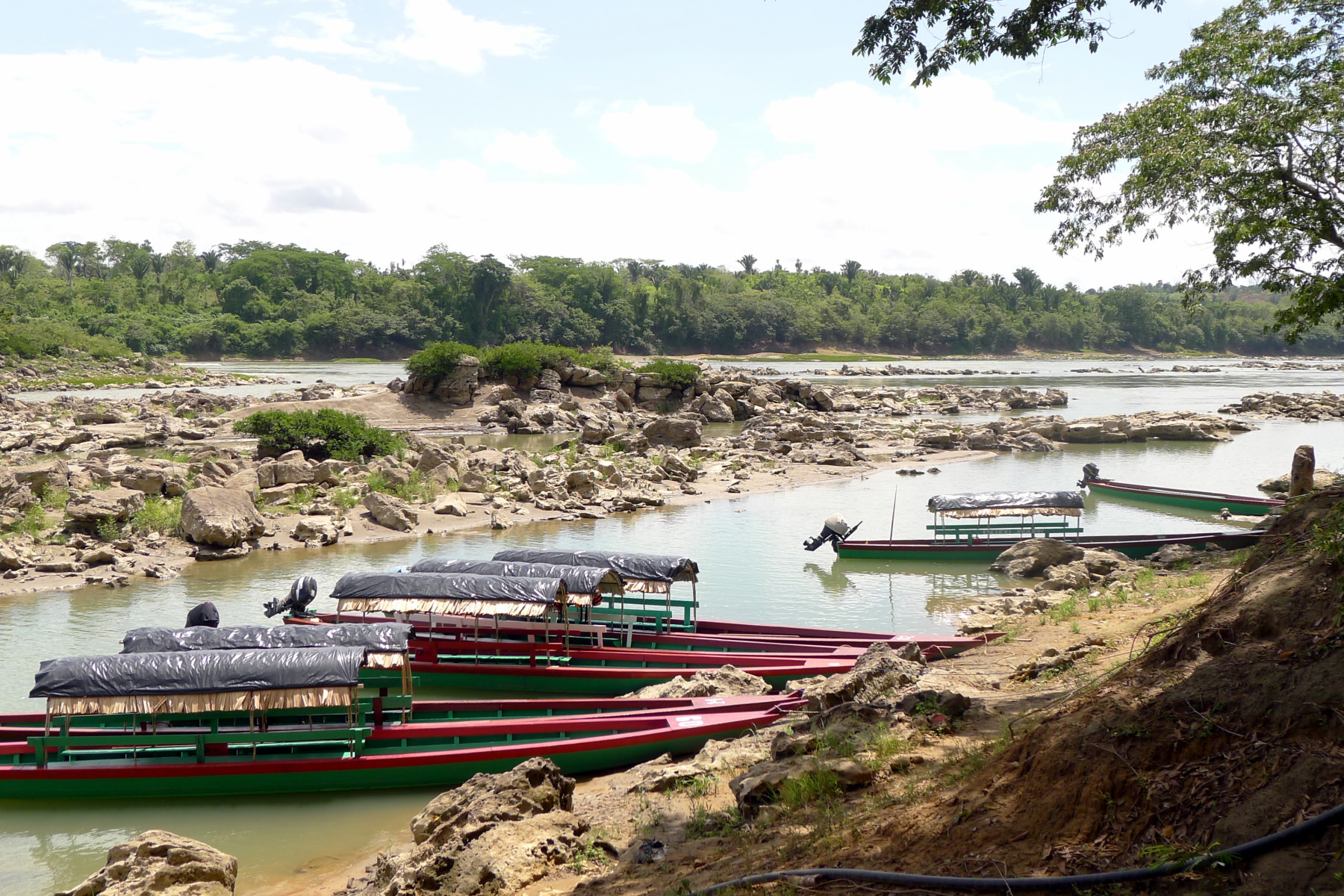
The only way to get to Yaxchilán is on the Usumacinta River. Boats wait for tourists in Frontera de Corozal.
Nach Yaxchilán gelangt man nur auf dem Fluss Usumacinta. In Frontera de Corozal warten Boote auf Touristen.
The ruins of Yaxchilán can only be reached by boat. Since the beginning of the 1990s, there has been a road to Frontera de Corozal on the Usumacinta. From there, the trip on the river takes about an hour. Before that, the ruins could only be reached by a small plane or after a river journey of more than 150 kilometres that lasted for days.
Zu den Ruinen von Yaxchilán kommt man nur mit einem Boot. Seit Beginn der 1990er-Jahre gibt es eine Straße nach Frontera de Corozal am Usumacinta. Von dort dauert die Fahrt auf dem Fluss eine knappe Stunde. Davor waren die Ruinen nur mit einem kleinen Flugzeug oder nach einer tagelangen Flussreise von über 150 Kilometern erreichbar.

Long wooden boats with powerful outboards take tourists to the Mayan ruins within an hour.
Lange Holzboote mit starken Außenbordern bringen die Touristen in knapp einer Stunde zu den Maya-Ruinen.
The Rio Usumacinta has a lot of water and flows into the Gulf of Mexico. The river passes the limestone mountains of the Sierra del Lacandón and forms in this region the border between Guatemala and Mexico over many hundreds of kilometres. On the Guatemalan side, there is a national park: Parque Nacional Sierra del Lacandón. Here there is still virgin forest with rare animals, while the Mexican side is already heavily cleared.
The river was an important artery on which other Maya cities were located: Piedras Negras downstream at a distance of 40 kilometres from Yaxchilán, and Altar de Sacrificios 80 kilometres upstream, both on the right and east of the Usumacinta respectively, i.e. in Guatemala.
Der Rio Usumacinta ist der wasserreichste Fluss Mittelamerikas und mündet in den Golf von Mexiko. Zuvor fließt er durch die Kalkberge der Sierra del Lacandón und bildet über viele Hundert Kilometer die Grenze zwischen Guatemala und Mexiko. Auf der Seite Guatemalas erstreckt sich ein Nationalpark: der Parque Nacional Sierra del Lacandón. Hier gibt es noch Urwald mit seltenen Tieren, während die mexikanische Seite schon stark gerodet ist.
Der Fluss war eine bedeutende Verkehrsader, an der weitere Maya-Städte lagen: Piedras Negras flussabwärts in 40 Kilometern Entfernung von Yaxchilán, 80 Kilometer flussaufwärts Altar de Sacrificios, beide rechts beziehungsweise östlich des Usumacinta, also in Guatemala.
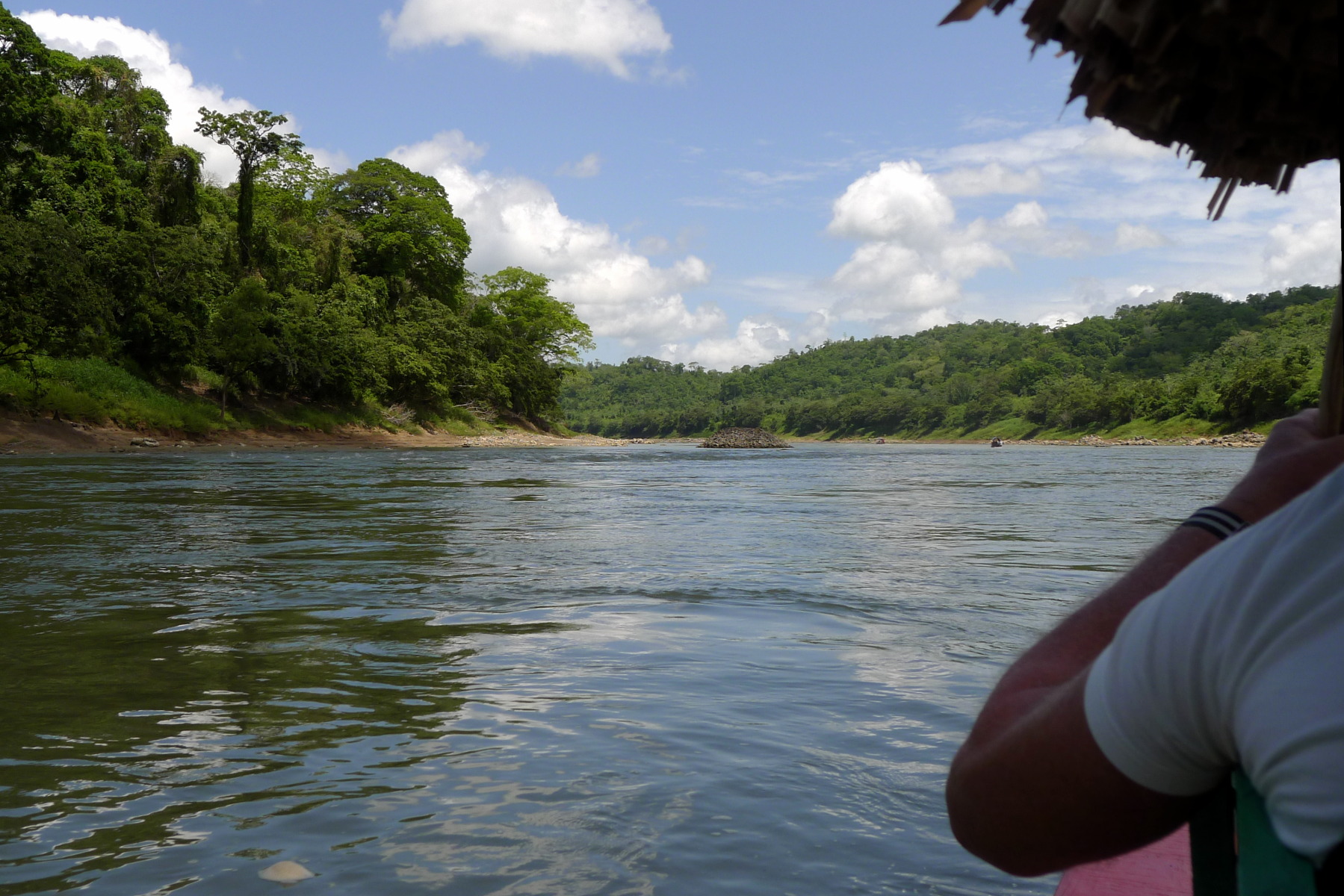
Right next to the river, the rainforest is still largely intact. On the left the Mexican bank, on the right Guatemala. The stone hill in the background already belongs to Yaxchilán.
Unmittelbar am Fluss ist der Regenwald noch weitgehend intakt. Links das mexikanische Ufer, rechts Guatemala. Der Steinhügel im Hintergrund gehört schon zu Yaxchilán.
Yaxchilán lies at the zenith of a narrow, horseshoe-shaped loop of the Usumacinta and is thus protected from the river on all sides. It is best to look at it on a map: Only in the south of the city remains a land access about 500 metres wide.
Yaxchilán liegt im Scheitelpunkt einer engen, hufeisenförmigen Schleife des Usumacinta und ist so nach allen Seiten vom Fluss geschützt. Am besten schaut man sich das auf einer Karte an: Nur im Süden der Stadt bleibt ein etwa 500 Meter breiter Landzugang.
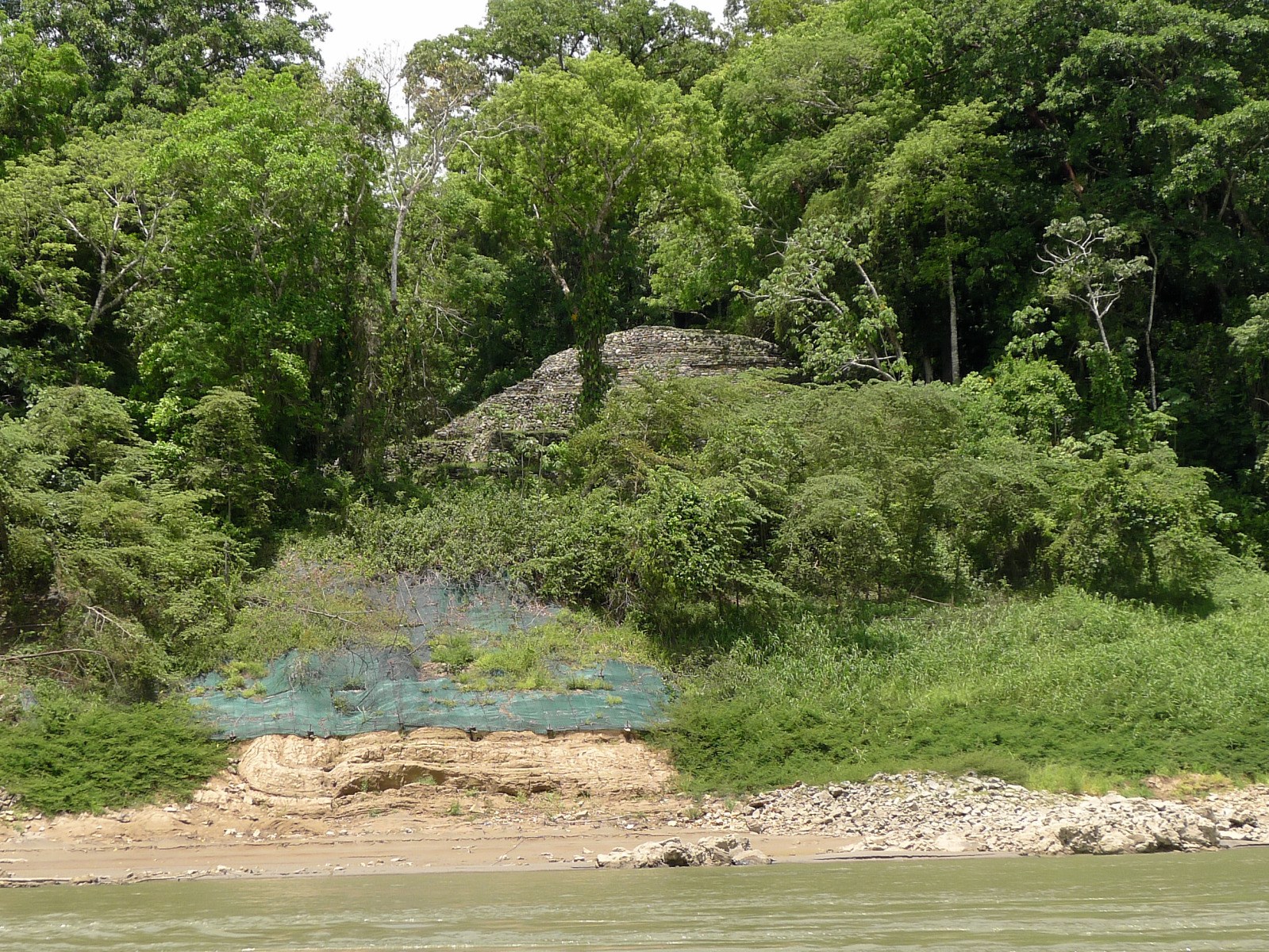
From the boat you can already see the first Mayan ruin on the shore. Yaxchilán ruled the river for centuries.
Vom Boot aus sieht man am Ufer schon die erste Maya-Ruine. Yaxchilán beherrschte Jahrhunderte lang den Fluss.
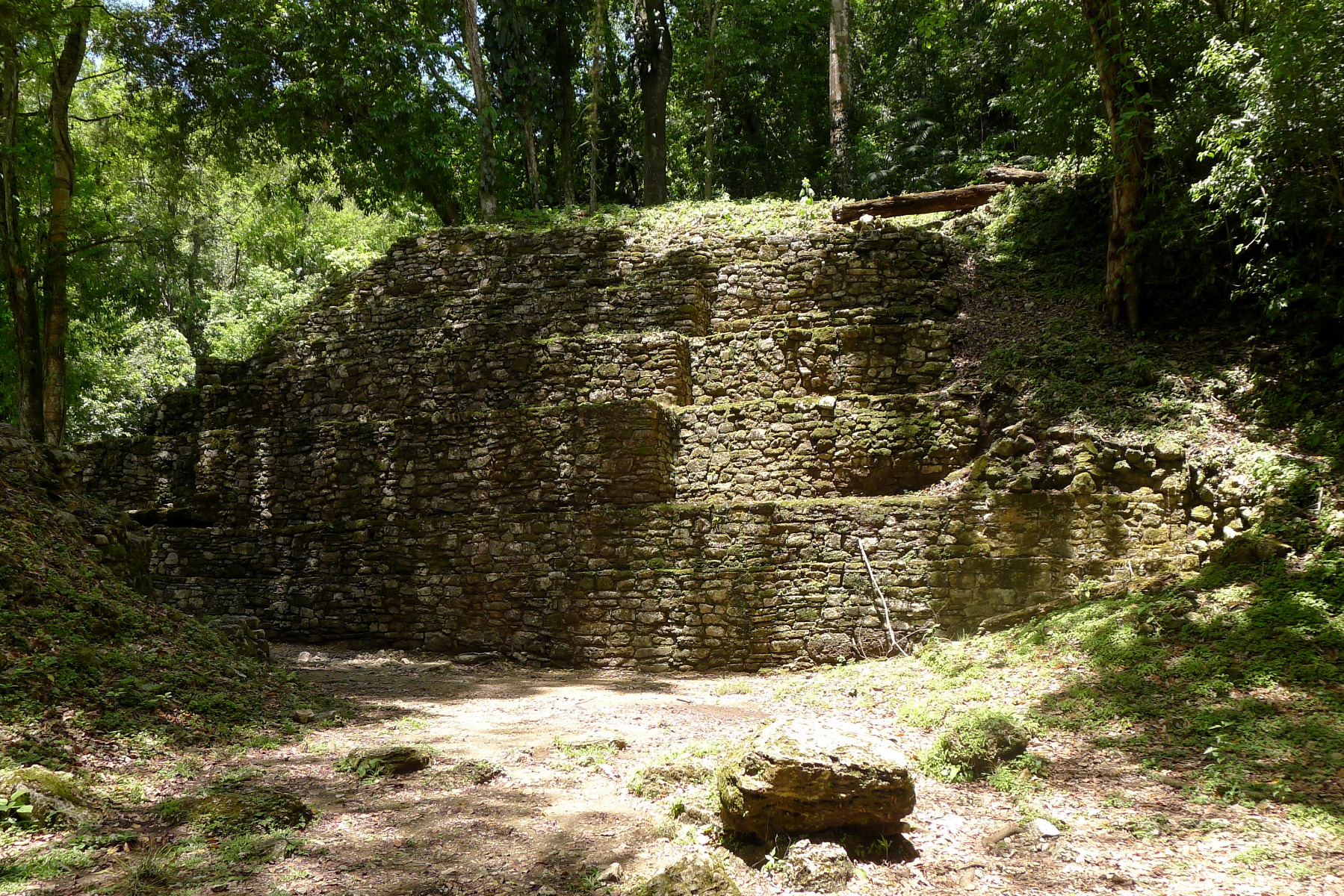
Today's entrance area at the point where one enters the site from the river bank.
Der heutige Eingangsbereich an der Stelle, wo man vom Flussufer aus die Ruinestätte betritt.
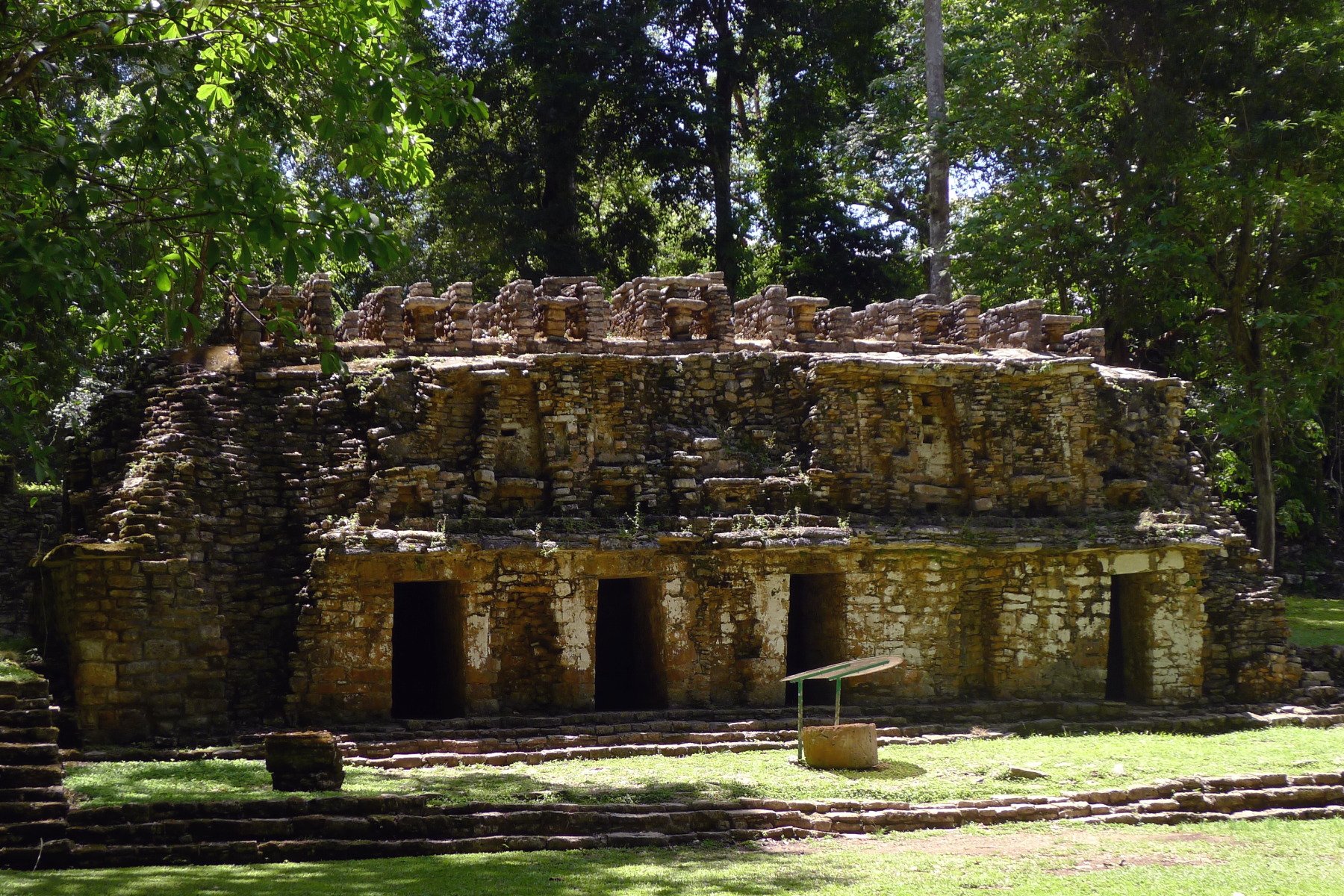
Building 19 with three floors, also called »Labyrinth«, on the north-western edge of a large square.
Gebäude 19 mit drei Stockwerken, auch »Labyrinth« genannt, am nordwestlichen Rand eines großen Platzes.
The buildings have numbers that most authors use in their descriptions. I have tried to match my photos to the correct numbers. At the end of the post you will find a simple map with the most important buildings in the centre of the Maya city.
Today's access to the ruins leads through a dark corridor in building 19. This large building is also called the labyrinth and forms the western end of the grounds.
Die Bauten haben Nummern, die von den meisten Autoren bei ihren Beschreibungen verwendet werden. Ich habe versucht, meine Fotos den korrekten Nummern zuzuordnen. Am Schluss des Posts findet Ihr einen einfachen Plan mit den wichtigsten Gebäuden im Zentrum der Maya-Stadt.
Der heutige Zugang zu den Ruinen führt durch einen dunklen Gang in Gebäude 19. Dieser große Bau wird auch das Labyrinth genannt und bildet den westlichen Abschluss des Geländes.

Bats hanging on the ceiling of the labyrinth (building 19).
In den falschen Gewölben des Labyrinths (Gebäude 19) hängen Fledermäuse.
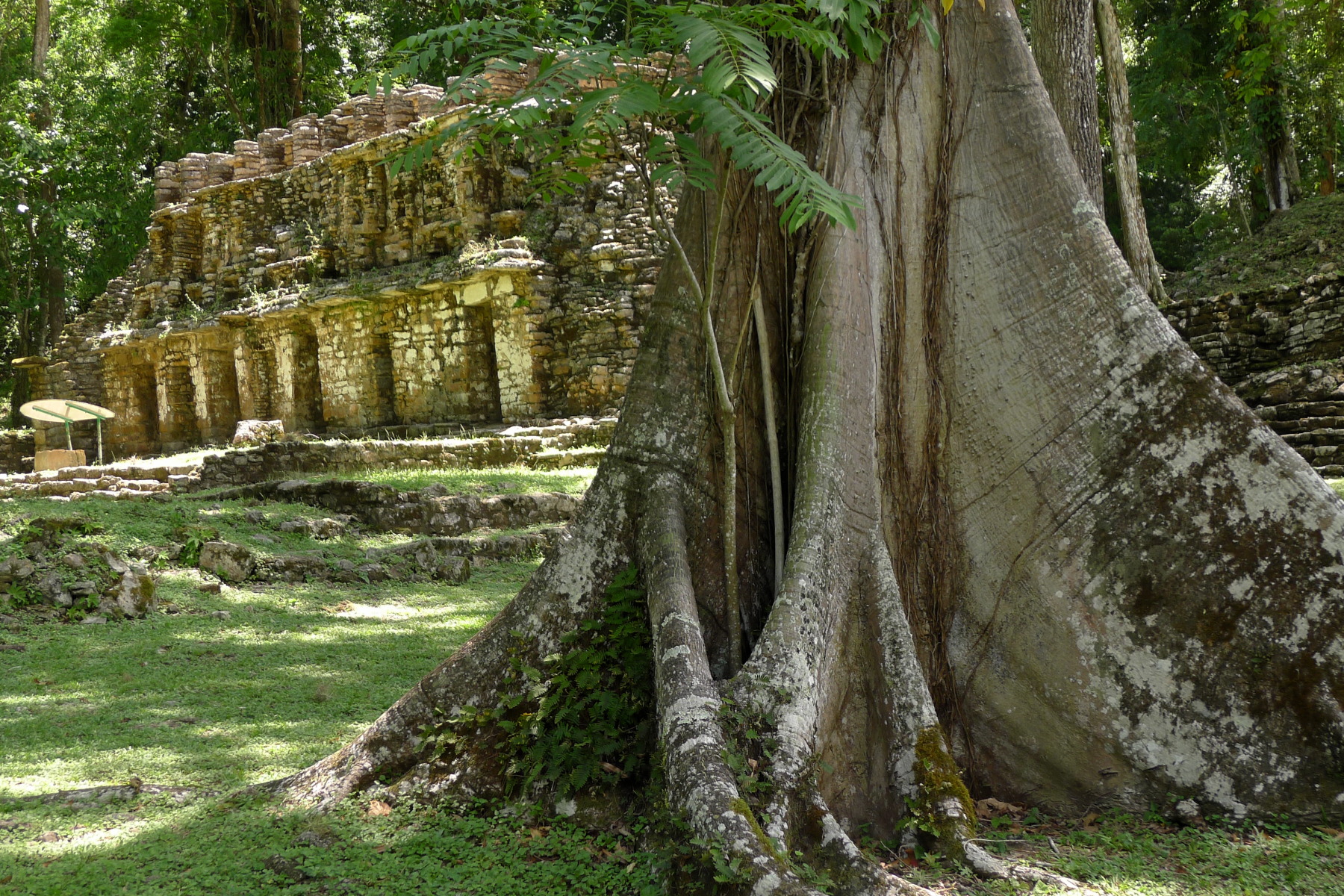
View from the main square back to the labyrinth (building 19).
Blick vom Hauptplatz zurück auf das Labyrinth (Gebäude 19).
A large main square stretches from northwest to southeast. It is called the »Gran Plaza« or »central acropolis«: Numerous more or less well-preserved buildings are grouped around this main square, including a ball court.
The few tourists get lost in the extensive grounds, and most of the time you are all alone on your wanderings through the ruins. The main square has been cleared to make the ruins visible, but there are still some giant trees between the buildings, in whose branches spider monkeys cavort.
Ein großer Hauptplatz erstreckt sich von Nordwesten nach Südosten. Er wird als »Gran Plaza« oder »zentrale Akropolis« bezeichnet: Um diesen Hauptplatz gruppieren sich zahlreiche mehr oder weniger gut erhaltene Gebäude, darunter auch ein Ballspielplatz.
Die wenigen Touristen verlieren sich in dem ausgedehnten Gelände, meistens ist man ganz allein bei seinen Streifzügen durch die Ruinen. Der Hauptplatz wurde gerodet, um die Bauten sichtbar zu machen, aber es stehen noch einige Baumriesen zwischen den Gebäuden, in deren Geäst sich Klammeraffen tummeln.
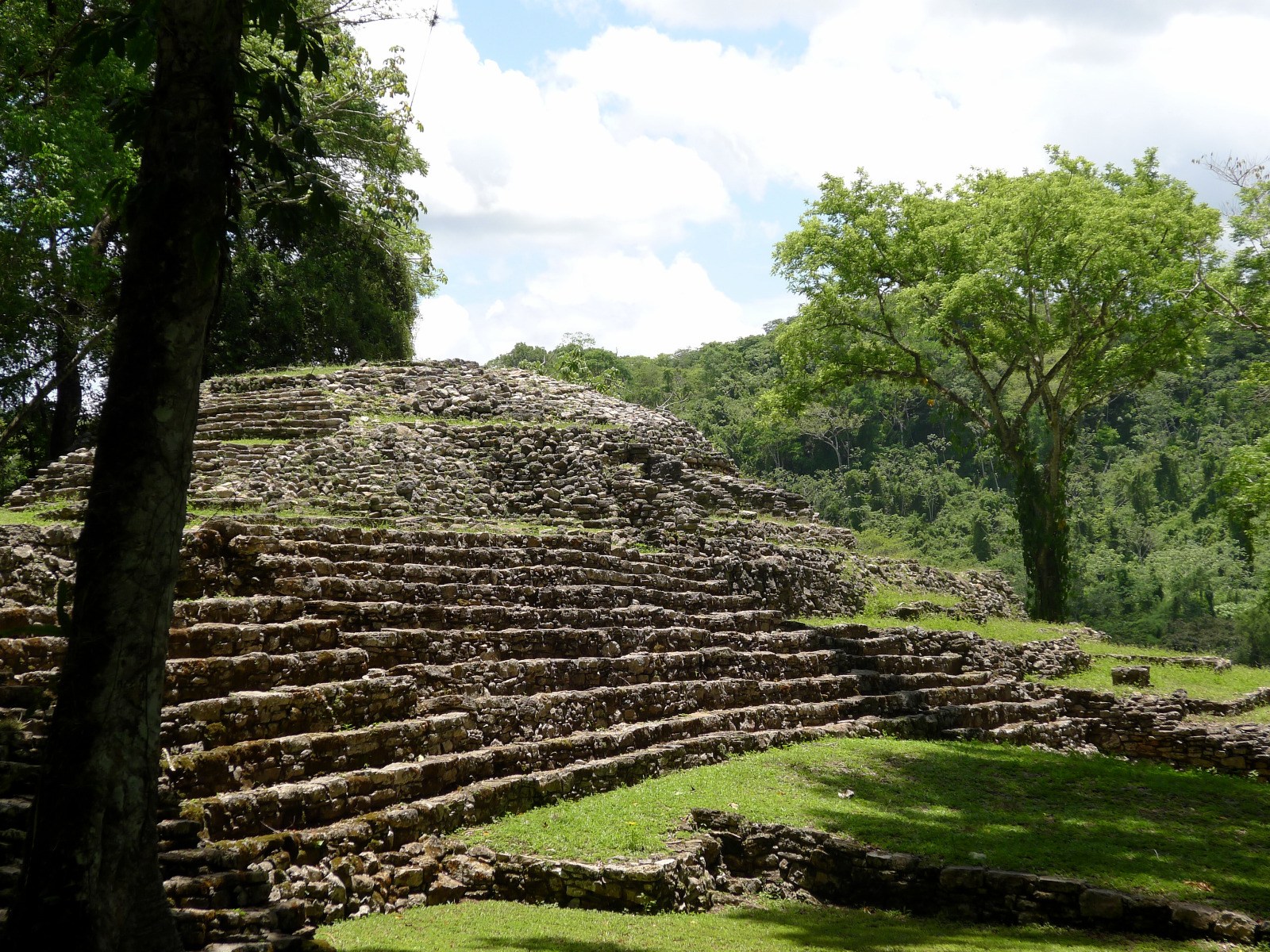
Building 18, like No. 19, is located on the north-western edge of the large square, the central Acropolis.
Gebäude 18 liegt wie Nr. 19 am nordwestlichen Rand des großen Platzes, der zentralen Akropolis.

Ball court in the middle of the central Acropolis.
Ballspielplatz inmitten der zentralen Akropolis.
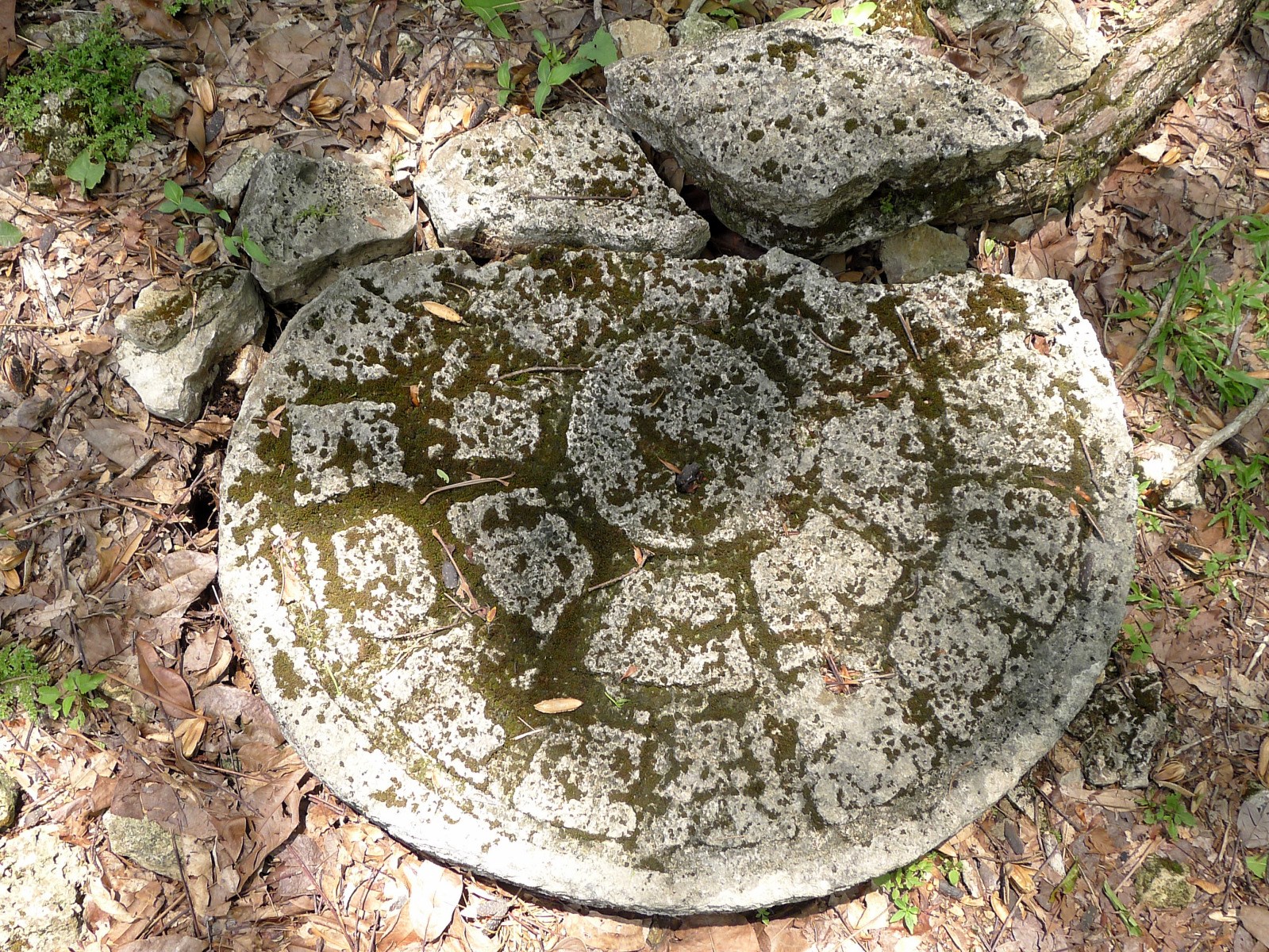
Markers dividing the playing field are still preserved on the ball court.
Auf dem Ballspielplatz sind noch Marken erhalten, die das Spielfeld unterteilten.

Main square with building 22.
Blick auf den Hauptplatz mit Gebäude 22.
The temple buildings of Yaxchilán are not as well preserved as those in Palenque or even Chichén Itzá. But due to their isolated location by the river deep in the rainforest, the ruins emanate an incomparable atmosphere.
Members of the Maya people of the Lancandones, who live according to ancient custom, still come here to worship their gods: in 1999 Reinhard Krüger photographed a bird sacrifice by the Lacandones at a cult stone in Yaxchilán – this would be impossible in Chichén Itzá.
At the south-eastern end of the main square follow two relatively well-preserved buildings, No. 20 with three rooms and, high above the river, the probably Early Classical building No. 6: this was the original entrance to the city in Maya times.
Die Tempelbauten von Yaxchilán sind lange nicht so gut erhalten wie in Palenque oder gar in Chichén Itzá. Aber durch ihre abgeschiedene Lage am Fluss tief im Regenwald strahlen die Ruinen eine unvergleichliche Atmosphäre aus.
Nach alter Sitte lebende Angehörige des Maya-Volks der Lancandonen kommen immer noch hierher, um ihre Götter zu verehren: 1999 fotografierte Reinhard Krüger ein Vogelopfer der Lacandonen an einem Kultstein in Yaxchilán – in Chichén Itzá wäre das undenkbar.
Am südöstlichen Ende des Hauptplatzes folgen zwei relativ gut erhaltene Gebäude, Nr. 20 mit drei Räumen und, hoch über dem Fluss, das vermutlich frühklassische Gebäude Nr. 6: Das war der ursprüngliche Zugang zur Stadt in der Zeit der Maya.

Building 6 above the river is possibly Early Classical (before 600 AD) – that would make it one of the oldest temples still standing here.
Gebäude 6 über dem Fluss ist möglicherweise frühklassisch (vor 600 n.Chr.) – dann wäre es einer der ältesten Tempel, die hier noch stehen.
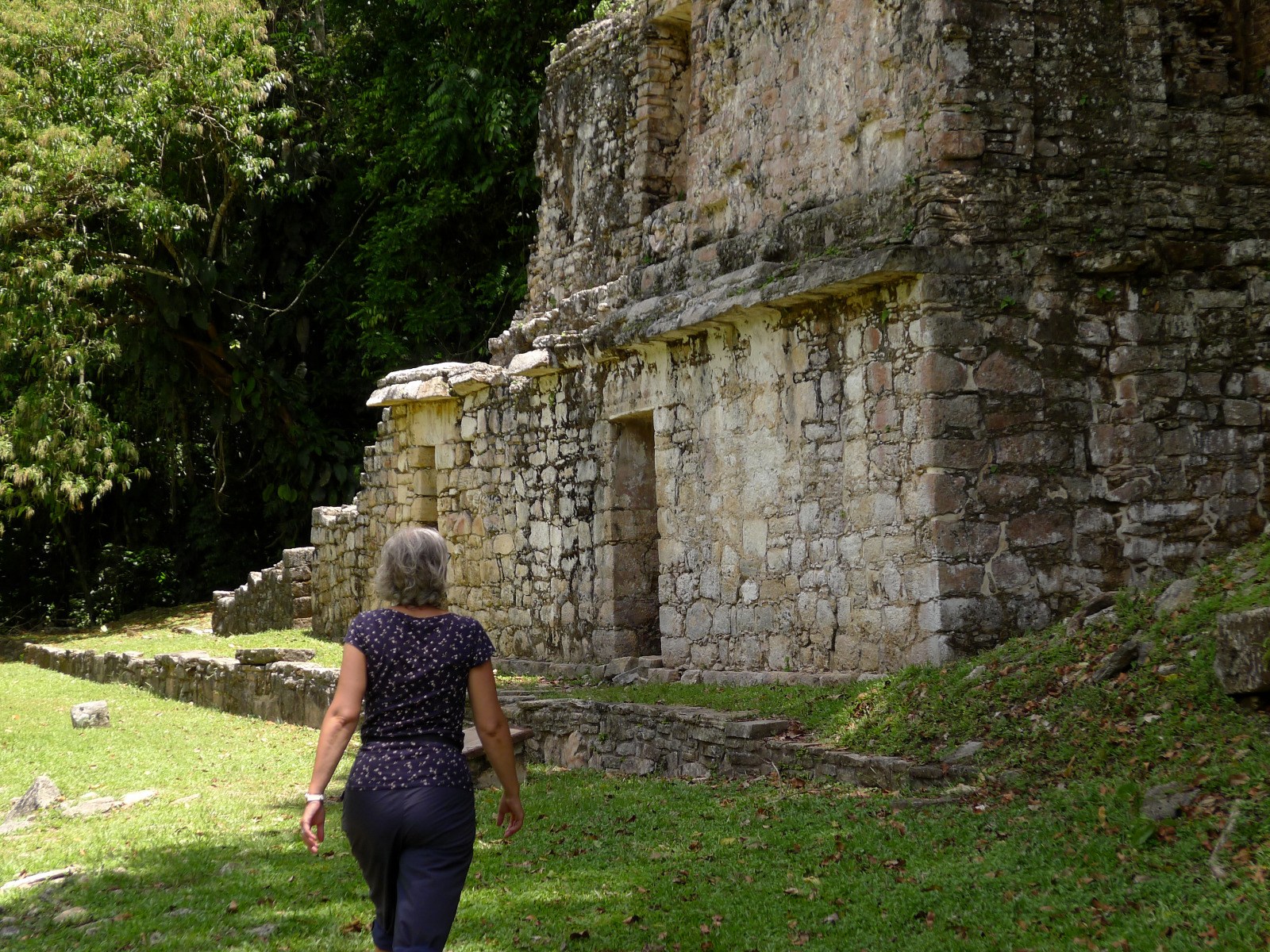
Building 20, which is in relatively good condition, has three rooms and, like Building 6, stands at the south-eastern end of the main square.
Das relativ gut erhaltene Gebäude 20 hat drei Räume und steht wie Gebäude 6 am südöstlichen Ende des Hauptplatzes.
The Classic Time of the Maya – Die klassische Zeit der Maya
The Classic period of the Maya extends from 250 to 900 AD. This period is further divided into the Early and Late Classical periods, which lasted from 250 to 600 and 600 to 900. The period from around 900 until the arrival of the Spanish in the 16th century is called the Postclassic. Most of the ruins preserved in Chichén Itzá or Izamal, for example, belong to this »Postclassic« period.
Yaxchilán existed pretty much in the classical Maya period. Inscriptions from the city record a total of 19 kings, the first from around 350, the last mention dates from 810. Like so many other Maya cities, Yaxchilán was left in the 9th century. So when the first Europeans came there, the ruins had been lying abandoned in the jungle for over 1000 years.
Die klassische Zeit der Maya reicht von 250 bis 900 nach Christus. Diese Periode unterteilt man noch einmal in die frühe und späte Klassik, die von 250 bis 600 beziehungsweise 600 bis 900 dauerte. Den Abschnitt ab etwa 900 bis zu Ankunft der Spanier im 16. Jahrhundert bezeichnet man als Postklassik. In diese »nachklassische« Zeit gehören zum Beispiel die meisten Ruinen, die in Chichén Itzá oder Izamal erhalten sind.
Yaxchilán existierte ziemlich genau in der klassischen Zeit der Maya. Inschriften aus der Stadt überliefern insgesamt 19 Könige, den ersten ab etwa 350, die letzte Erwähnung stammt aus dem Jahr 810. Wie so viele andere Maya-Städte auch wurde Yaxchilán im 9. Jahrhundert aufgegeben. Als die ersten Europäer dorthin kamen, lagen die Ruinen also seit über 1000 Jahren verlassen im Urwald.
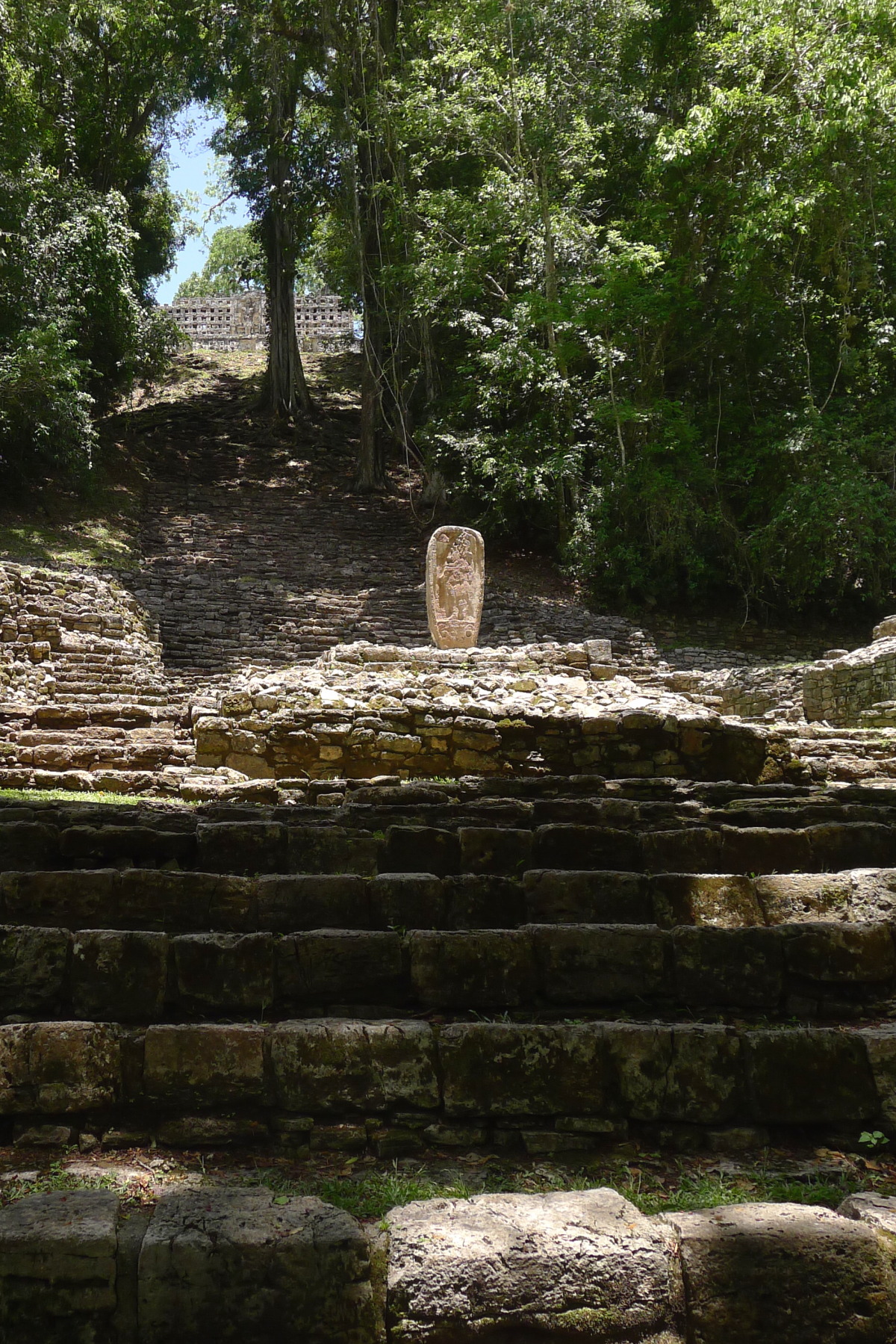
A massive staircase leads to the highest point of the central Acropolis with building 33.
Eine gewaltige Treppe führt zum höchsten Punkt der zentralen Akropolis mit dem Gebäude 33.
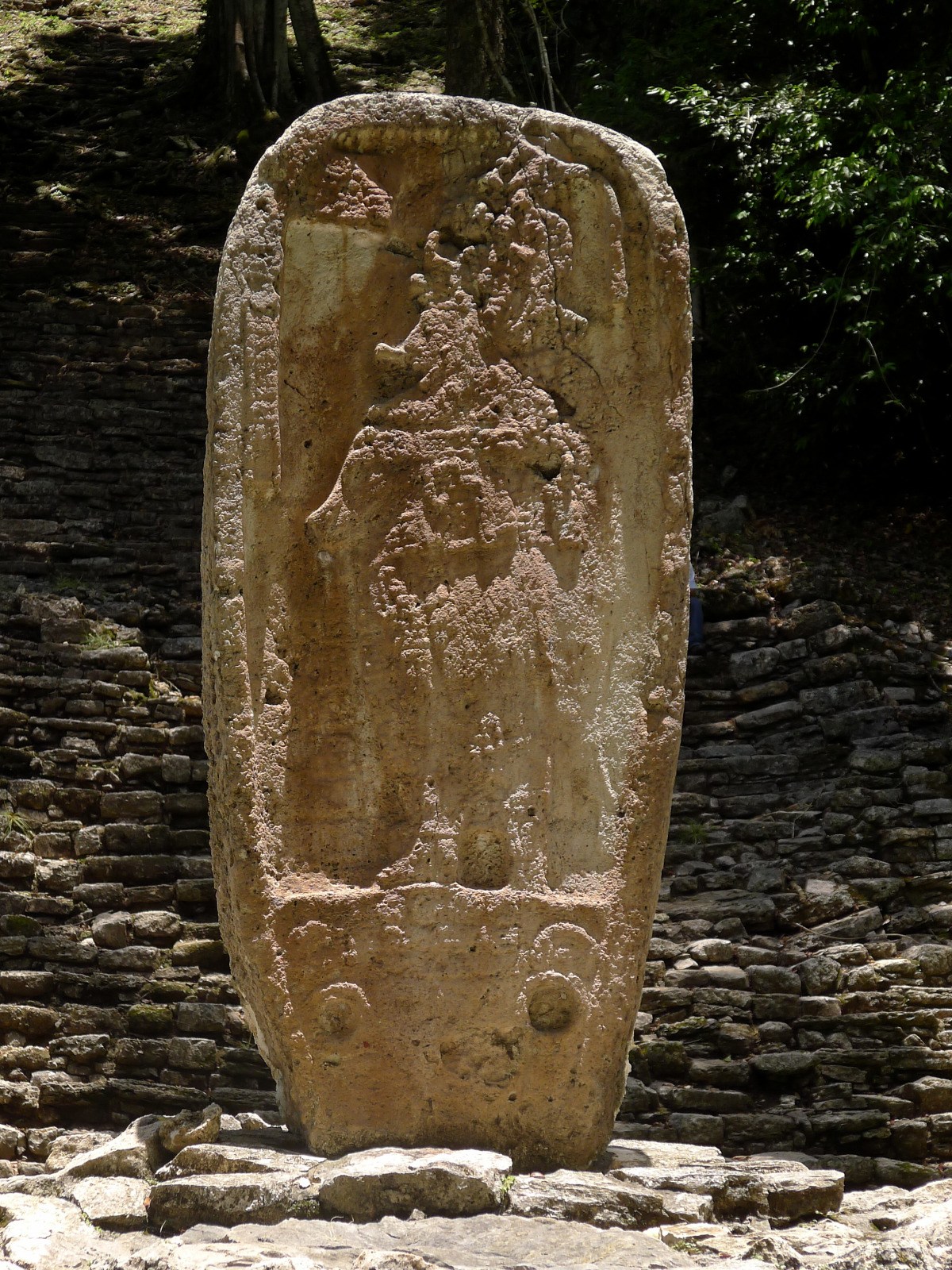
A weathered stele stands on a platform of the stairs to building 33. It is said to date from the year 613, so it is older than the stairs and the building and was erected here later.
Auf einer Plattform der Treppe zu Gebäude 33 steht eine verwitterte Stele. Sie soll aus dem Jahr 613 stammen, ist also älter als Treppe und Gebäude und nachträglich hier aufgestellt worden.
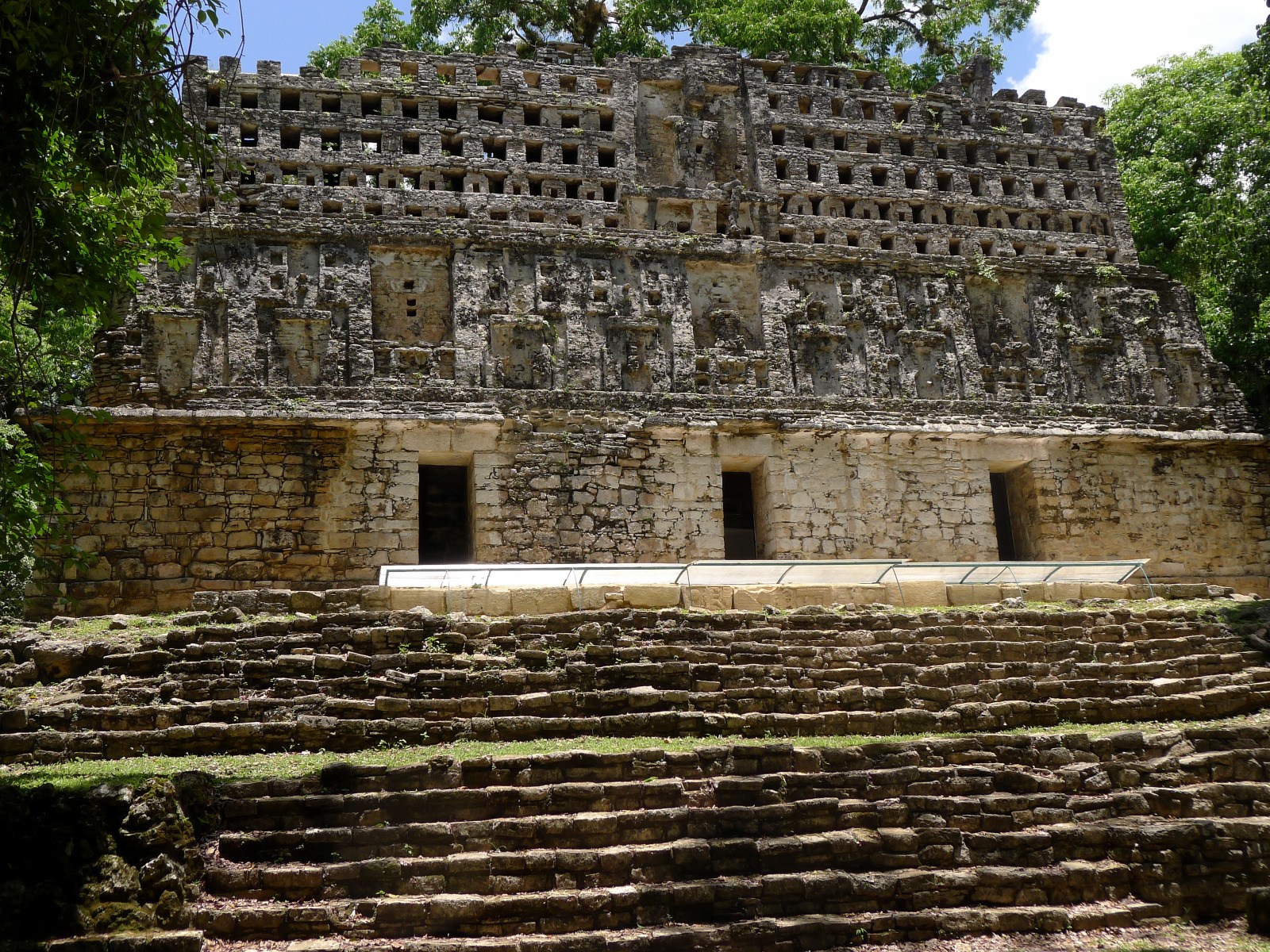
Building 33 on the highest point was probably inaugurated in 756. The blocks of the top step show reliefs (photo below) and are therefore protected by a plastic roof.
Gebäude 33 auf dem höchsten Punkt wurde vermutlich im Jahr 756 eingeweiht. Die Blöcke der obersten Treppestufe zeigen Reliefs (Foto siehe unten) und werden deshalb durch ein Plastikdach geschützt.
At the highest point, Building 33 overlooks the entire central acropolis and the Usumacinta River. At the largest and most beautiful temple of Yaxchilán, the roof comb is still very well preserved. The roof comb is an important component of Maya buildings, a kind of headdress of the temple, analogous to the costume of the kings, who also wore strange formations on their heads.
Building 33 was built in the zenith when Yaxchilań ruled the river and the surrounding towns almost undisputedly. The temple was probably inaugurated in 756 by Bird Jaguar IV. This King reigned from 752 to 768.
Auf dem höchsten Punkt überblickt Gebäude 33 die gesamte zentrale Akropolis und den Fluss Usumacinta. Bei dem größten und schönsten Tempel von Yaxchilán ist der Dachkamm noch sehr gut erhalten. Der Dachkamm ist ein wichtiges Bestandteil der Maya-Bauten, eine Art Kopfschmuck des Tempels, analog zur Tracht der Könige, die ebenfalls seltsame Gebilde auf ihren Häuptern trugen.
Gebäude 33 entstand in der Blütezeit, als Yaxchilań fast unumstritten den Fluss und die umliegenden Städte beherrschte. Der Tempel wurde wohl im Jahr 756 von Bird Jaguar IV eingeweiht. König Bird Jaguar IV regierte von 752 bis 768.
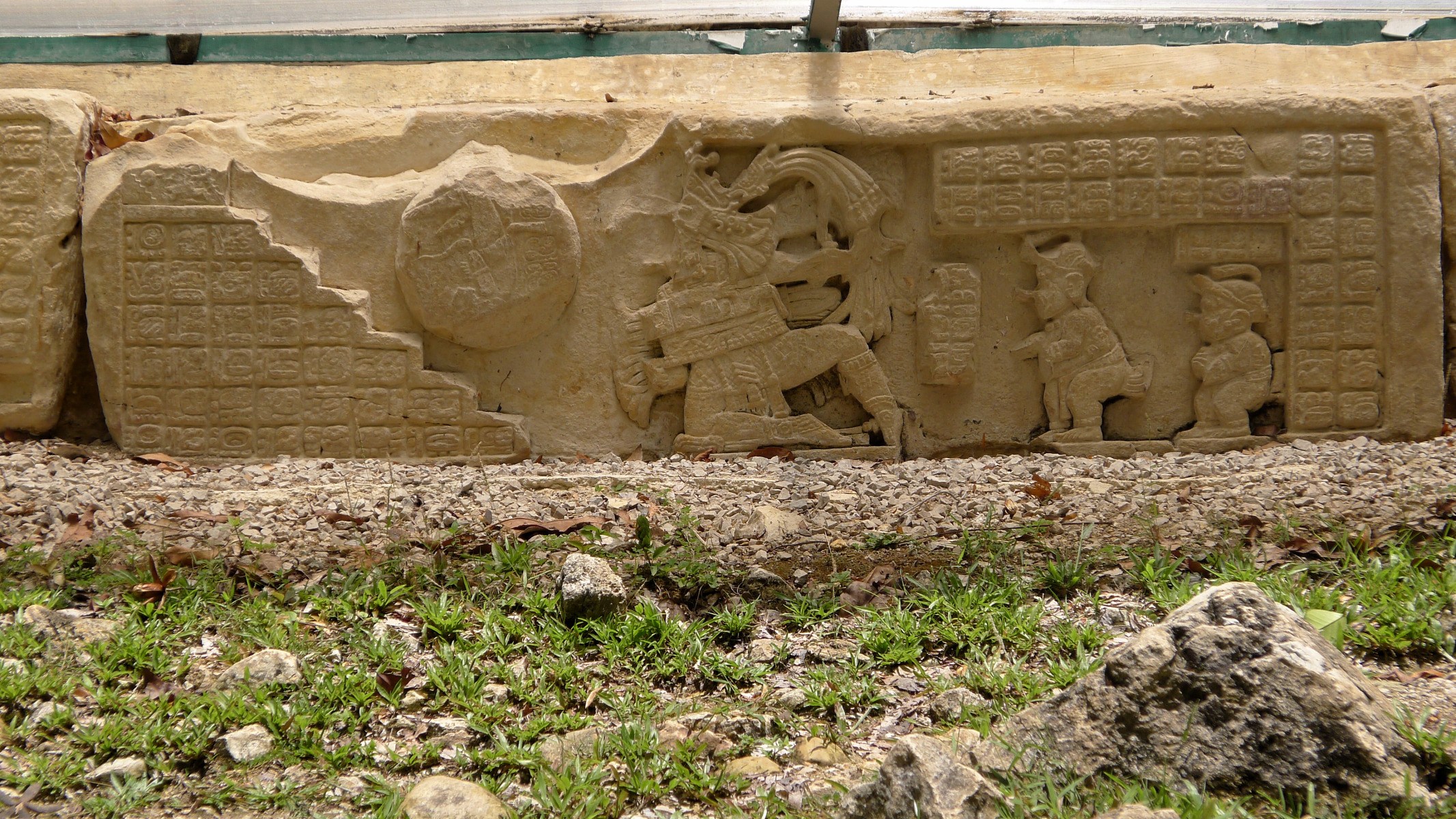
Carved top step in front of building 33: In the centre King Bird Jaguar IV, on the left a ball, on the right two dwarfs watching the king playing ball. Hieroglyphs explain the scene.
Behauene oberste Treppenstufe vor Gebäude 33: In der Mitte König Bird Jaguar IV, links ein Ball, rechts zwei Zwerge, die dem König beim Ballspiel zuschauen. Hieroglyphen erläutern die Szene.
The top step of the staircase to temple building 33 consists of 13 blocks. They show King Bird Jaguar IV playing ball. A prisoner can be seen rolled up in the ball. It is important to know that the Maya sometimes sacrificed their prisoners of war by tying them up like a ball and rolling them down the stairs in front of their temples.
Strangely enough, two dwarfs are watching the king playing ball. I have not found an explanation for this. On the right and left, the ancestors of Bird Jaguar IV are depicted on further blocks (not on the photo): on the left, father Shield Jaguar II, on the right, grandfather Bird Jaguar III, both also playing ball.
Die oberste Stufe der Treppe zum Tempel Gebäude 33 besteht aus 13 behauenen Blöcken. Sie zeigen König Bird Jaguar IV beim Ballspiel. Im Ball ist quasi zusammengerollt ein Gefangener erkennbar. Dazu muss man wissen, dass die Maya ihre Kriegsgefangenen manchmal opferten, indem sie sie wie einen Ball zusammenschnürten und die Treppen vor ihren Tempeln hinunterrollten.
Merkwürdigerweise schauen zwei Zwerge dem König beim Ballspiel zu. Eine Erklärung dafür habe ich nicht gefunden. Rechts und links sind auf weiteren Blöcken die Vorfahren von Bird Jaguar IV dargestellt (nicht auf dem Foto): links Vater Shield Jaguar II., rechts Großvater Bird Jaguar III, beide ebenfalls beim Ballspiel.

Next to the large temple No. 33, there are other very well preserved buildings on the platform above the stairs (Nos. 25 and 26, not specifically noted on the plan at the end of the post).
Neben dem großen Tempel Nr. 33 stehen auf der Plattform oberhalb der Treppe weitere sehr gut erhaltene Gebäude (Nr. 25 und 26, auf dem Plan am Schluss des Posts nicht extra vermerkt).
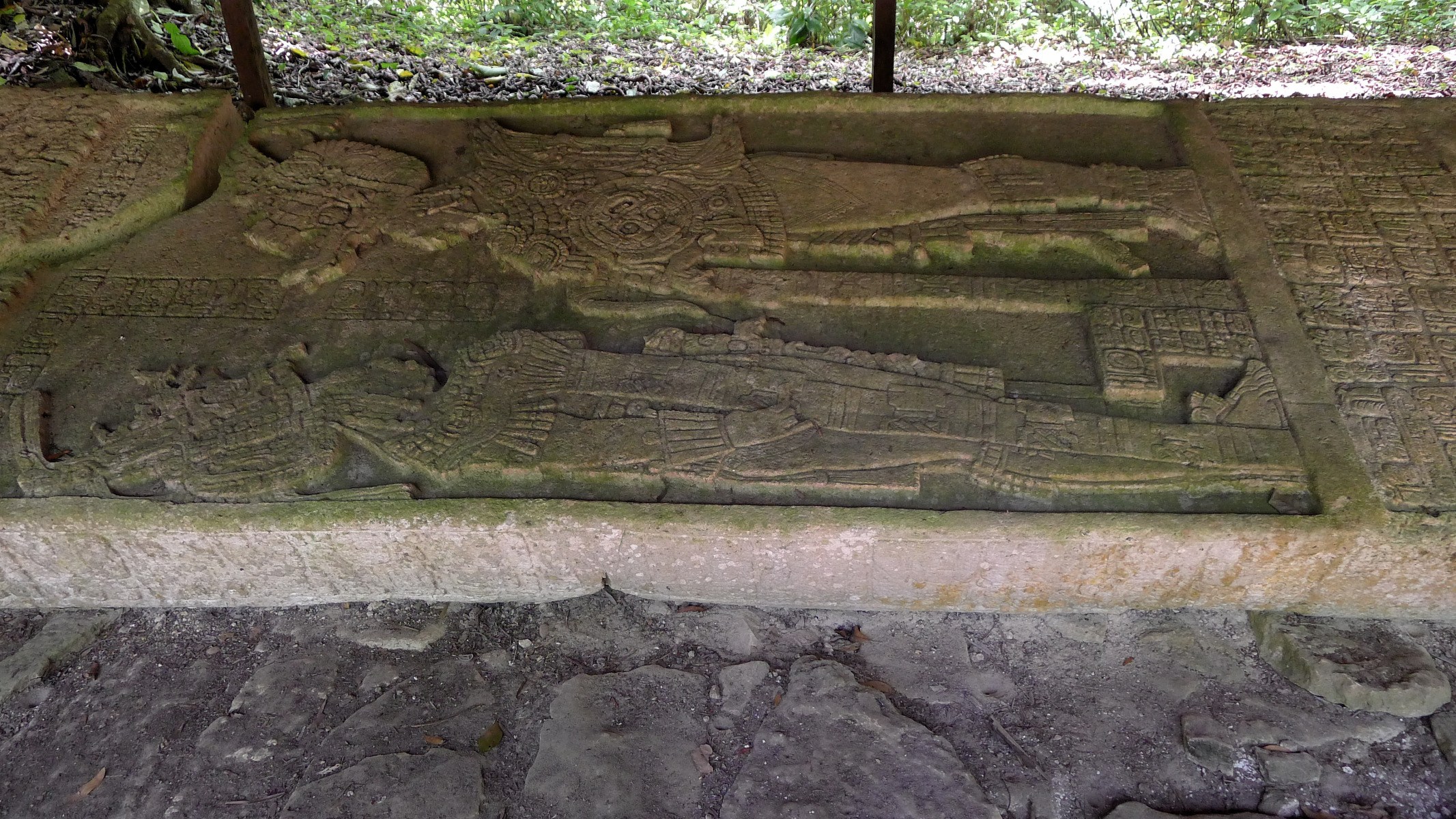
Large stele with two kings and hieroglyphs. Stele 11 lies on the ground protected by a roof.
Große Stele mit zwei Königen und Hieroglyphen. Stele 11 liegt auf dem Boden geschützt durch ein Dach.
On the great square, protected by a roof, lies Stele 11, weighing several tons. It shows – how could it be otherwise – King Bird Jaguar IV, the builder of the temple Building 33. Next to him stands his father Shield Jaguar II.
King Shield Jaguar II reigned for over 60 years from 681 to 742. During this long period, Yaxchilán attained supra-regional importance. When Shield Jaguar II died in 742, he was over 90 years old. We will come to his wife, Lady Eveningstar, the mother of Bird Jaguar IV, in a moment.
Stele No. 11 is not from the central acropolis where it is now, but originally stood in front of building 40. Building 40 is part of the so-called small acropolis about 150 metres away to the south-west of the large square on another hill (not on the plan shown below).
In 1964, the stele was dismantled in front of Building 40 and transported by ship a good 20 kilometres upstream on the Usumacinta to Agua Azul. From there, the stone was to be taken by plane to Mexico City to be exhibited in the Museo Nacional de Antropología.
However, the stone proved too heavy for the plane, so it was brought back to Yaxchilán in 1965, where it has been lying on the ground near the shore ever since, protected from the weather by a roof.
Auf dem Ruinengelände liegt geschützt durch ein Dach die tonnenschwere Stele 11. Sie zeigt – wie sollte es anders sein – König Bird Jaguar IV, den Erbauer des Tempels Gebäude 33. Neben ihm steht sein Vater Shield Jaguar II.
König Shield Jaguar II regierte über 60 Jahre lang von 681 bis 742. In dieser langen Regierungszeit erlangte Yaxchilán überregionale Bedeutung. Als Shield Jaguar II 742 starb, war er über 90 Jahre alt. Zu seiner Frau, Lady Eveningstar, der Mutter von Bird Jaguar IV, kommen wir gleich noch.
Die Stele Nr. 11 stammt nicht von der zentralen Akropolis, wo sie jetzt liegt, sondern stand ursprünglich vor Gebäude 40. Gebäude 40 ist Teil der sogenannten kleinen Akropolis etwa 150 Meter entfernt südwestlich des großen Platzes auf einem weiteren Hügel (nicht auf dem unten abgebildeten Plan).
Im Jahr 1964 baute man die Stele vor Gebäude 40 ab und transportierte sie per Schiff auf dem Usumacinta gut 20 Kilometer flussaufwärts nach Agua Azul. Von dort sollte der Stein mit dem Flugzeug nach Mexico City gebracht werden, um ihn im Museo Nacional de Antropología auszustellen.
Der Stein erwies sich jedoch als zu schwer für das Flugzeug, weshalb man ihn 1965 zurück nach Yaxchilán brachte, wo er seitdem in der Nähe des Ufers auf dem Boden liegt, vor der Witterung durch ein Dach geschützt.

Stele 35: Lady Eveningstar in building 21.
Stele 35: Lady Eveningstar in Gebäude 21.
It was not until 1983 that the extraordinarily well-preserved stele 35 was found during archaeological excavations in building 21. It was lying in the rubble between stones from the collapsed temple roof. The relief shows Lady Eveningstar, the wife of Shield Jaguar II (King 681–742) and mother of Bird Jaguar IV (King 752–768).
Lady Eveningstar is said to have been a beauty. She came from Calakmul, a very important Maya city in present-day Campeche, after all almost 200 kilometres from Yaxchilán as the crow flies. The long-lived Shield Jaguar II had married Lady Eveningstar to bring peace between the two warring cities. A lively building activity and many reliefs from the time of Bird Jaguar IV probably testify to his precarious position as the son of a »foreign« princess.
Once there were over 30 stelae in the city. Eleven of these stelae stood on the central acropolis, facing the river. From there, travellers could look up at the sculptures of the kings of Yaxchilán dressed as warriors.
When researchers began to systematically examine Yaxchilán at the end of the 19th century, they found not only numerous stelae, but also carved lintels decorated with sculptures and some steps, such as the top step in front of the large temple Building 33. The well-known Maya researcher Alfred Maudslay brought some of the lintels to Great Britain in 1882; he also took plaster casts. The most beautiful reliefs from Yaxchilán can therefore be seen in the British Museum in London. The inscriptions from Yaxchilán played an important role in the decipherment of the Maya hieroclyphics, which was finally almost completed in 1983. Today, 90 percent of the characters can be read.
Erst 1983 wurde bei archäologischen Ausgrabungen in Gebäude 21 die außerordentlich gut erhaltene Stele 35 gefunden. Sie lag im Schutt zwischen Steinen, die vom eingestürzten Tempeldach stammten. Das Relief zeigt Lady Eveningstar, die Frau von Shield Jaguar II (König 681–742) und Mutter von Bird Jaguar IV (König 752–768).
Lady Eveningstar soll eine Schönheit gewesen sein. Sie stammte aus Calakmul, einer sehr bedeutenden Maya-Stadt im heutigen Campeche, immerhin knapp 200 Kilometer Luftlinie von Yaxchilán entfernt. Der langlebige Shield Jaguar II hatte Lady Eveningstar geheiratet, um Frieden zwischen den beiden sich bekämpfenden Städten zu stiften. Eine rege Bautätigkeit und viele Reliefs aus der Zeit von Bird Jaguar IV zeugen wohl von dessen prekären Stellung als Sohn einer »fremden« Prinzessin.
Einst gab es in der Stadt über 30 Stelen. Elf dieser Stelen standen auf der zentralen Akropolis mit der Schauseite zum Fluss. Von dort konnten Reisende auf die Skulpturen der als Krieger gekleideten Könige Yaxchiláns hinaufblicken.
Als Ende des 19. Jahrhunderts Forscher damit begannen, Yaxchilán systematisch zu untersuchen, fanden sie nicht nur zahlreiche Stelen, sondern auch behauene, mit Skulpturen verzierte Türstürze und einige Treppenstufen wie die oberste Stufe vor dem großen Tempel Gebäude 33. Einen Teil der bearbeiteten Türstürze brachte der bekannte Mayaforscher Alfred Maudslay 1882 nach Großbritannien, zudem nahm er Gipsabgüsse. Die schönsten Reliefs von Yaxchilán kann man deshalb im Britischen Museum in London sehen. Die Inschriften von Yaxchilán spielten eine wichtige Rolle bei der Entzifferung der Maya-Schrift, die letztlich erst 1983 fast vollständig gelang. Heute können 90 Prozent der Zeichen gelesen werden.
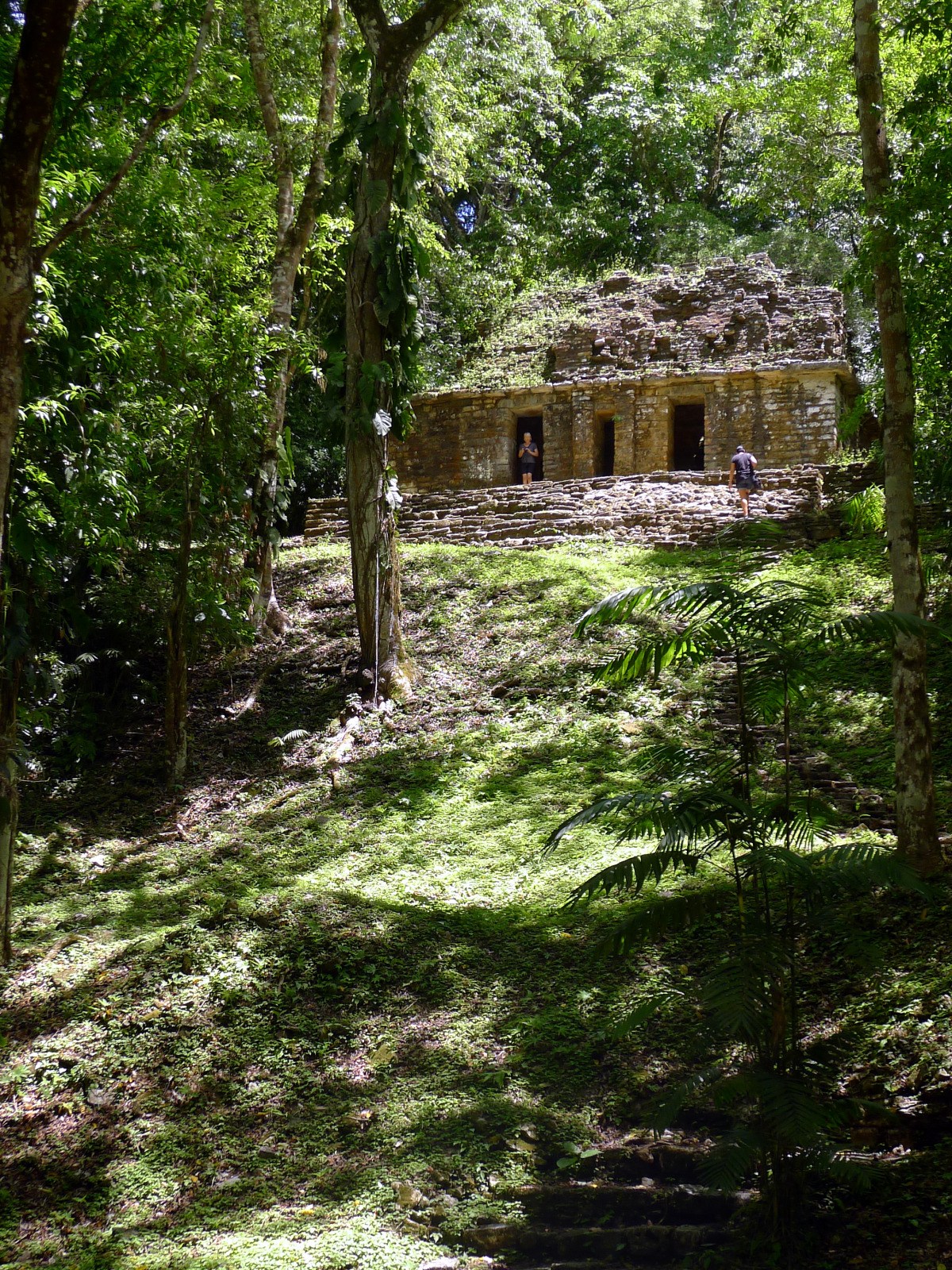
Building 40 on the small acropolis (allocation not entirely certain).
Gebäude 40 auf der kleinen Akropolis (Zuordnung nicht ganz sicher).
About 150 metres southwest of the large square, another mound with several buildings overlooks the surroundings. In front of it, several stelae were recovered, some with dates around 740. Stela 11 originally stood here, too, but now lies on the ground near the bank under a roof. The ruins have almost been swallowed up by the surrounding jungle.
Etwa 150 Meter südwestlich des großen Platzes überragt ein weiterer Hügel mit mehreren Gebäuden die Umgebung. Davor wurden mehrere Stelen geborgen, teils mit Daten um 740. Hier stand ursprünglich auch Stele 11, die jetzt in der Nähe des Ufers unter einem Dach auf dem Boden liegt. Die Ruinen hat der umgebende Urwald fast schon wieder verschluckt.
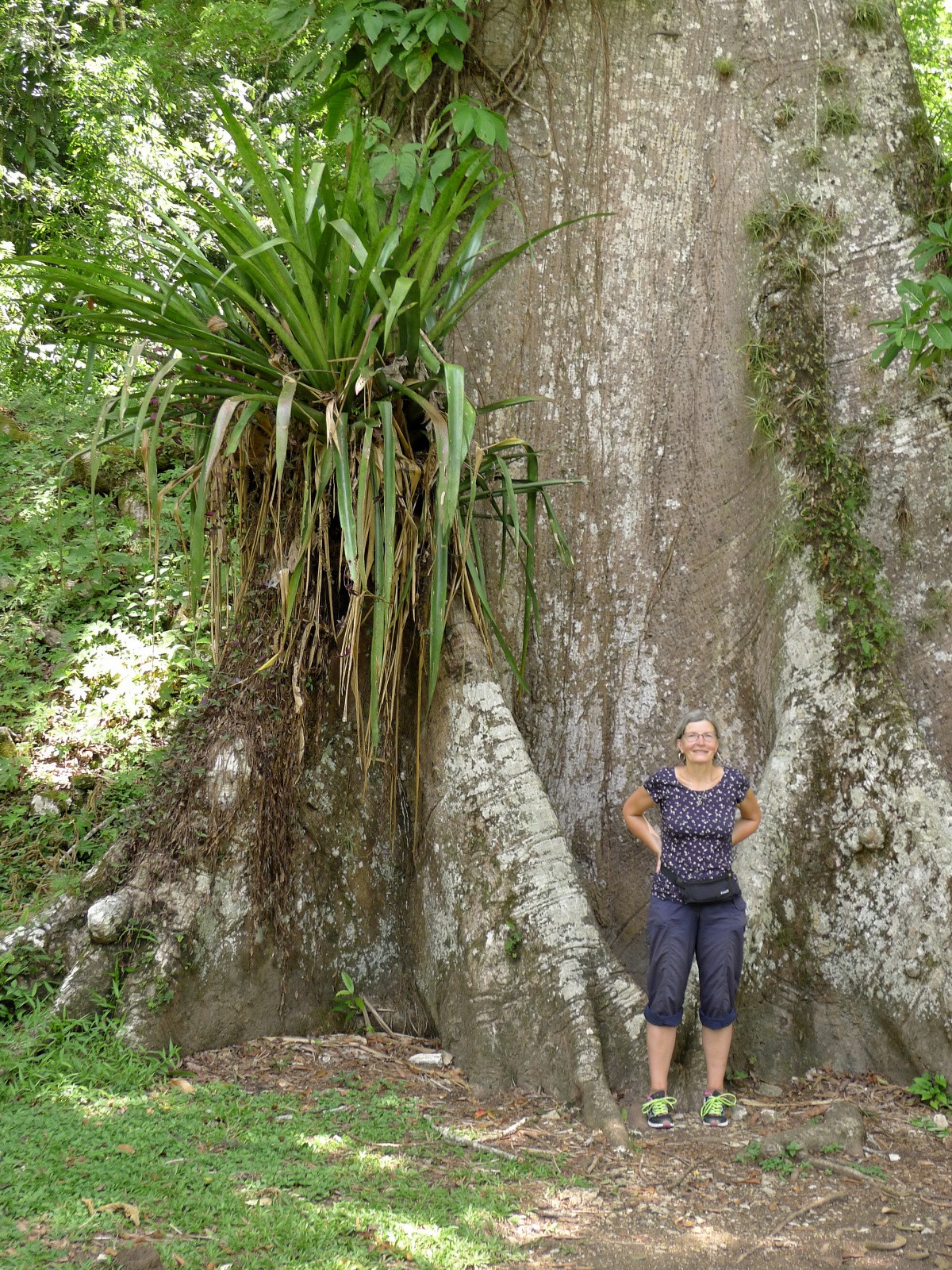
Ceiba (kapok tree) in Yaxchilán: Ceibas can live for over 500 years. So the ruins of Yaxchilan had been abandoned for half a millennium when this tree began to grow.
Ceiba (Kapokbaum) in Yaxchilán: Ceibas können über 500 Jahre alt werden. Die Ruinen von Yaxchilan lagen also schon ein halbes Jahrtausend verlassen, als dieser Baum zu wachsen begann.
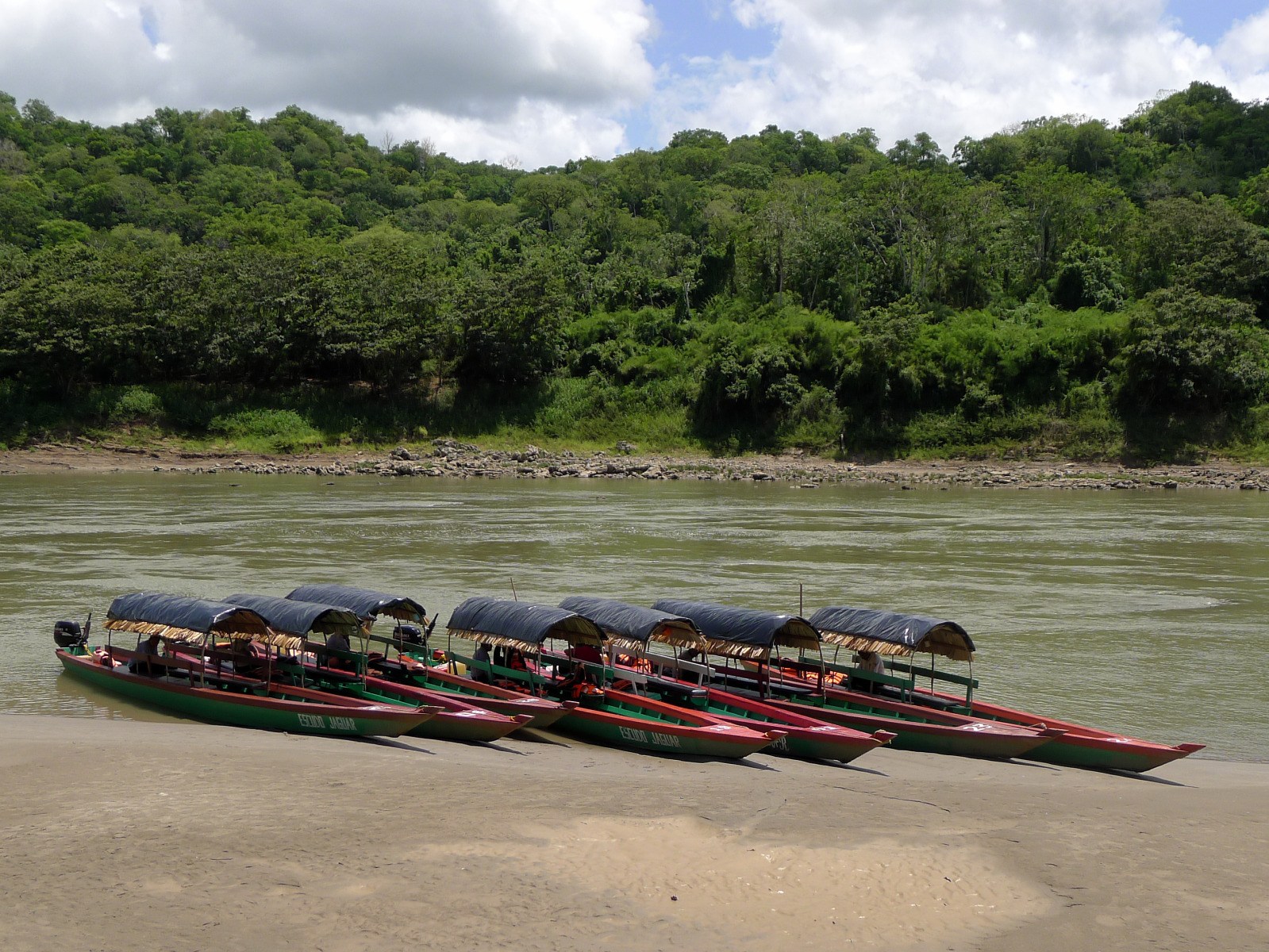
Farewell to Yaxchilán: Boats on the banks of the Usumacinta wait for tourists.
Abschied von Yaxchilán: Boote am Ufer des Usumacinta warten auf Touristen.
For decades there have been plans to dam the Usumacinta to generate energy from hydropower. If this comes true, the ruins of Yaxchilán will be lost forever.
Many tourists come to Palenque. From there, Yaxchilán is a relatively easy two-hour drive. I can only recommend a trip there: From the drive through the mountains of the Sierra del Lacandón to the boat trip on the Usumacinta to the mysterious atmosphere of the Yaxchilán ruin site: it will be an unforgettable experience.
Seit Jahrzehnten gibt es Pläne, den Usumacinta aufzustauen um Energie aus der Wasserkraft zu gewinnen. Wenn das wahr wird, sind die Ruinen von Yaxchilán für immer verloren.
Viele Touristen kommen nach Palenque. Von dort ist Yaxchilán in gut zwei Stunden Fahrt relativ einfach zu erreichen. Ich kann einen Ausflug dorthin nur empfehlen: Von der Fahrt durch die Berge der Sierra del Lacandón über die Bootstour auf dem Usumacinta bis hin zu der geheimnisvollen Atmosphäre der Ruinenstätte Yaxchilán: Es wird ein unvergessliches Erlebnis.
Sources – Quellen
In my opinion, the best description of the buildings and especially the reliefs of Yaxchilán has been published online by Alyson Jackson under the title Mexico: Yaxchilan April/May 2012. The following map, which clearly shows most of the buildings of the central acropolis, also comes from this website. This map is highly simplified, but it is the only one that really helps to identify individual buildings.
Die beste Beschreibung der Bauten und insbesondere der Reliefs von Yaxchilán hat meiner Ansicht nach Alyson Jackson unter dem Titel Mexico: Yaxchilan April/May 2012 online gestellt. Von dieser Webseite stammt auch die folgende Karte, in der übersichtlich die meisten Gebäude der zentralen Akropolis eingzeichnet sind. Diese Karte ist zwar stark vereinfacht, aber die einzige, die wirklich hilft, einzelne Gebäude zu identifizieren.
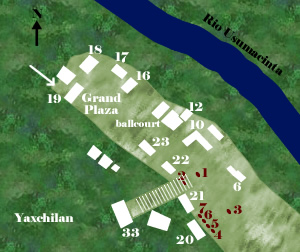
Simple plan of the buildings of Yaxchilán. Red numbers are stelae. I use the map with permission from Alyson Jackson: Many thanks! The most important buildings mentioned above: 6 Possibly Early Classical temple, entrance area at the time of the Maya. 19 Labyrinth in today's entrance area. 21 Building with stele of the Lady Evening Star. 33 Large temple on the highest point of the central acroplis, in front of it a huge staircase.
Einfacher Plan der Gebäude von Yaxchilán. Rote Nummern sind Stelen. Die Karte verwende ich mit Erlaubnis von Alyson Jackson: Herzlichen Dank! Die wichtigsten oben erwähnten Gebäude: 6 Möglicherweise frühklassischer Tempel, Eingangsbereich zur Zeit der Maya. 19 Labyrinth im heutigen Eingangsbereich. 21 Gebäude mit Stele der Lady Evening Star. 33 Großer Tempel auf dem höchsten Punkt der zentralen Akroplis, davor eine riesige Treppe. Ballcourt – Ballspielplatz
Further Sources – Weitere Quellen
At Wikipedia, the English version lists all buildings, stelae, lintels and worked steps individually with number and briefly describes them. In particular, there is a table at the end with an overview of the kings of Yaxchilán. Very good photos and a useful plan can be found at Khan Acadamy.
Bei Wikipedia werden in der englischen Fassung alle Gebäude, Stelen, Türstürze und bearbeiteten Stufen einzeln mit Nummer aufgeführt und kurz beschrieben. Insbesondere gibt es am Schluss eine Tabelle mit einer Übersicht über die Könige von Yaxchilán. Sehr gute Fotos und einen brauchbaren Plan findet man bei Khan Acadamy.

sieht und hört sich wirklich traumhaft an!
@tipu curate
Upvoted 👌 (Mana: 36/48) Liquid rewards.
Ja, das war ein ungewöhnliches Reiseerlebnis, an das ich sehr gerne zurückdenke, gerade in der jetzigen Situation auch mit einer gewissen Wehmut.
kann ich mir gut vorstellen :/
Congratulations, your post has been added to Pinmapple! 🎉🥳🍍
Did you know you have your own profile map?
And every post has their own map too!
Want to have your post on the map too?
Wow, dass sind wirklich einige sehr interessante Fotos. Gerade als jemand mit Interesse für Geschichte, kommt da schon ein wenig Fernweh auf um sich das ganze einmal in echt anzusehen. Üblicherweise reblogge ich ja nicht oft, aber Du hast es Dir definitiv verdient!
Herzlichen Dank für die Blumen! Ich freue mich natürlich sehr, wenn meine Posts gut ankommen.
Hiya, @LivingUKTaiwan here, just swinging by to let you know that this post made it into our Top 3 in Daily Travel Digest #1220.
Your post has been manually curated by the @pinmapple team. If you like what we're doing, please drop by to check out all the rest of today's great posts and consider supporting other authors like yourself and us so we can keep the project going!
Become part of our travel community:
Thank you very much! I am of course very happy about the good rating. Very motivating!
Congratulations @mapetoke! You have completed the following achievement on the Hive blockchain and have been rewarded with new badge(s) :
Your next target is to reach 900 upvotes.
You can view your badges on your board and compare yourself to others in the Ranking
If you no longer want to receive notifications, reply to this comment with the word
STOPCheck out the last post from @hivebuzz:
Vielen Dank für den hervorragenden Post.
Liebe Grüße Michael
!invest_vote
!jeenger
Ich habe zu danken für die Aufmerksamkeit. Auf diese Weise macht das Bloggen Spaß!
@mima2606 denkt du hast ein Vote durch @investinthefutur verdient!
@mima2606 thinks you have earned a vote of @investinthefutur !
Your contribution was curated manually by @mima2606
Keep up the good work!
Wow, cool. Die muss ic hmir auch mal anschauen. Kommen gleich auf die Liste. !PIZZA
Unbedingt zu empfehlen. Viel Spaß auf Deinen Reisen, hoffentlich unbehelligt von Corona und ähnlichen Dingen-;)